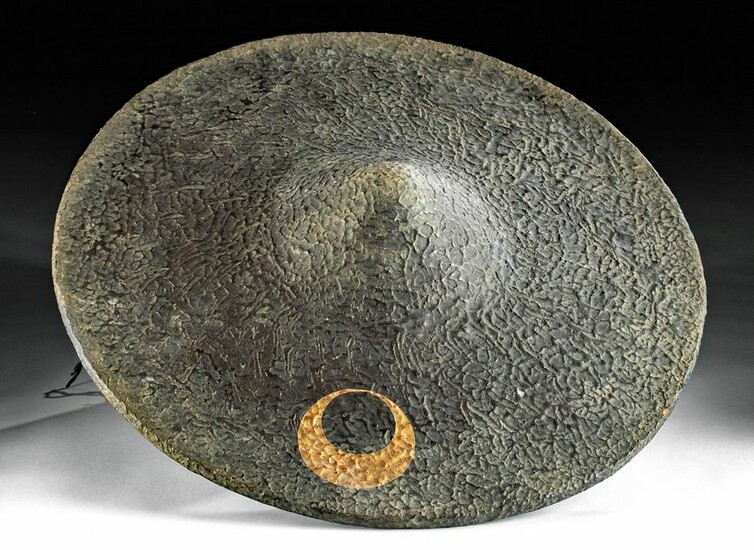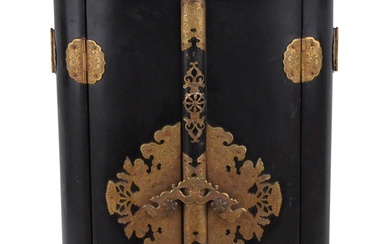19th C. Japanese Edo Lacquer Wood Samurai Jingasa Hat
East Asia, Japan, Edo to Meiji period, ca. late 19th to early 20th century CE. A black, lacquered wood jingasa or camp hat of a shallow circular form with a gold-hued family crest on the brim. The interior presents a central concave area for the wearer's head, with a padded cloth lining. Jingasa hats were worn by Japanese warriors during travel or encampment. Being lacquered, this jingasa was especially convenient as it was both waterproof and lightweight. During the Edo period, jingasa became more decorative, just like other samurai items, as they were increasingly used for display during sankin kotai. Size: 16" Diameter x 3.5" H (40.6 cm x 8.9 cm)
Sankin kotai, known as "alternate attendance," was developed during the Warring States period as a system to strengthen the Tokugawa shogunate's control over the feudal lords known as daimyos. The daimyo would alternate between residing in the shogun's castle in Edo and his own fief, usually on a yearly basis. However, while the daimyo may return to his home fief, his family was required to remain in Edo with the Shogun, essentially as hostages to ensure loyalty while the daimyo was away. When traveling to Edo the daimyo was accompanied by samurai and jingasa hats were worn during travel or encampment as a protective helmet. Being lacquered, this jingasa was especially convenient as it was both waterproof and lightweight. During the Edo period, jingasa became more decorative for these sankin kotai processions.
Provenance: ex-private Boulder, Colorado USA collection
All items legal to buy/sell under U.S. Statute covering cultural patrimony Code 2600, CHAPTER 14, and are guaranteed to be as described or your money back.
A Certificate of Authenticity will accompany all winning bids.
We ship worldwide to most countries and handle all shipping in-house for your convenience.
#162695
Condition Report: Some surface wear with losses and chipping to lacquer, with loss at the periphery of rim. Family crest has some fading but still vibrant. Padded fabric lining is worn, stained, and shows minor losses. Sections of padding are loose from the hat. Minor fraying to ends of ties.
View it on
Estimate
Time, Location
Auction House
East Asia, Japan, Edo to Meiji period, ca. late 19th to early 20th century CE. A black, lacquered wood jingasa or camp hat of a shallow circular form with a gold-hued family crest on the brim. The interior presents a central concave area for the wearer's head, with a padded cloth lining. Jingasa hats were worn by Japanese warriors during travel or encampment. Being lacquered, this jingasa was especially convenient as it was both waterproof and lightweight. During the Edo period, jingasa became more decorative, just like other samurai items, as they were increasingly used for display during sankin kotai. Size: 16" Diameter x 3.5" H (40.6 cm x 8.9 cm)
Sankin kotai, known as "alternate attendance," was developed during the Warring States period as a system to strengthen the Tokugawa shogunate's control over the feudal lords known as daimyos. The daimyo would alternate between residing in the shogun's castle in Edo and his own fief, usually on a yearly basis. However, while the daimyo may return to his home fief, his family was required to remain in Edo with the Shogun, essentially as hostages to ensure loyalty while the daimyo was away. When traveling to Edo the daimyo was accompanied by samurai and jingasa hats were worn during travel or encampment as a protective helmet. Being lacquered, this jingasa was especially convenient as it was both waterproof and lightweight. During the Edo period, jingasa became more decorative for these sankin kotai processions.
Provenance: ex-private Boulder, Colorado USA collection
All items legal to buy/sell under U.S. Statute covering cultural patrimony Code 2600, CHAPTER 14, and are guaranteed to be as described or your money back.
A Certificate of Authenticity will accompany all winning bids.
We ship worldwide to most countries and handle all shipping in-house for your convenience.
#162695
Condition Report: Some surface wear with losses and chipping to lacquer, with loss at the periphery of rim. Family crest has some fading but still vibrant. Padded fabric lining is worn, stained, and shows minor losses. Sections of padding are loose from the hat. Minor fraying to ends of ties.




